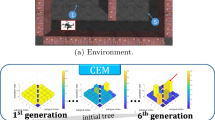Abstract
The concept of stratification (CST) has recently been proposed as an innovative approach in problem solving. CST takes a recursive approach to solve problems. It considers a system which has to transition through states until it arrives to a state which belongs to a desired set of states, namely a target set. The states can be stratified by enlarging the target (absorbing adjacent states). Incremental enlargement is a means to identify possible paths to achieve the target. Such an enlargement can also be used to degrade the target when the original target is not reachable. Although the characteristics of the concept, such as incremental enlargement, enhance its potential application in robotics, artificial intelligence, and planning and monitoring, there is a major shortcoming in the approach, namely its inability to consider targets of unequal importance. This study considers two targets of unequal importance for the system in CST, labelled Bi-Objective CST model (BOCST). In comparison with the original proposed CST model in this research, a version of CST with finite states which is much easier to apply than the original CST is proposed, labelled fuzzy CST. Following that, a combination of Fuzzy CST and BOCST (FBO-CST) is proposed. The model is then employed to address a restaurant selection problem using data from Google. The example illustrates how the model should be applied in a big data environment. By defining finite state CST and considering targets of unequal importance, this study is expected to facilitate future applications of CST.











Similar content being viewed by others
References
Zaniolo, C.: Expressing and supporting E ciently Greedy algorithms as locally stratified logic programs (2015)
Herencia, J.: Graded sets and points: a stratified approach to fuzzy sets and points. Fuzzy Sets Syst. 77(2), 191–202 (1996)
Dascalu, S.M., et al.: Stratified programming integrated development environment (SPIDER). In: IASSE (2003)
Brenes, D.J., Gayo-Avello, D.: Stratified analysis of AOL query log. Inf. Sci. 179(12), 1844–1858 (2009)
Qu, Y., et al.: Kernel-based fuzzy-rough nearest-neighbour classification for mammographic risk analysis. Int. J. Fuzzy Syst. 17(3), 471–483 (2015)
Balmin, A., et al.: Stratified sampling using adaptive parallel data processing. Google Patents (2017)
Zhang, Y., et al.: Fast model predictive control for multilevel cascaded h-bridge statcom with polynomial computation time. IEEE Trans. Ind. Electron. 63(8), 5231–5243 (2016)
Zadeh, L.A.: Stratification, target set reachability and incremental enlargement principle. Inf. Sci. 354, 131–139 (2016)
Asadabadi, M., Saberi, M., Chang, E.: Logistic informatics modelling using concept of stratification (CST). In: IEEE Fuzzy 2017. IEEE Xplore (2017)
Zadeh, L.A.: Toward a theory of fuzzy information granulation and its centrality in human reasoning and fuzzy logic. Fuzzy Sets Syst. 90(2), 111–127 (1997)
Yin, S., et al.: A data-driven fuzzy information granulation approach for freight volume forecasting. IEEE Trans. Ind. Electron. 64(2), 1447–1456 (2017)
Wu, Q., Wang, F., Zhou, L., Chen, H.: Method of multiple attribute group decision making based on 2-dimension interval type-2 fuzzy aggregation operators with multi-granularity linguistic information. Int. J. Fuzzy Syst. (2017). https://doi.org/10.1007/s40815-016-0291-9
Aggarwal, M.: Representation of uncertainty with information and probabilistic information granules. Int. J. Fuzzy Syst. 19(5), 1617–1634 (2017). https://doi.org/10.1007/s40815-016-0242-5
Klir, G., Yuan, B.: Fuzzy Sets and Fuzzy Logic, vol. 4. Prentice Hall, New Jersey (1995)
Peters, G.: Fuzzy Linear Regression with Fuzzy Intervals. Fuzzy Sets Syst. 63(1), 45–55 (1994)
Azadeh, A., et al.: Z-AHP: a Z-number extension of fuzzy analytical hierarchy process. In: 7th IEEE International Conference on Digital Ecosystems and Technologies (DEST). IEEE (2013)
Balal, E., Cheu, R.L.: Modeling of lane changing decisions: comparative evaluation of fuzzy inference system, support vector machine and multilayer feed-forward neural network (2017)
Mansourvar, M., et al.: A fuzzy inference system for skeletal age assessment in living individual. Int. J. Fuzzy Syst. 19(3), 838–848 (2017)
Pakkiraiah, B., Sukumar, G.D.: Enhanced performance of an asynchronous motor drive with a new modified adaptive neuro-fuzzy inference system-based MPPT controller in interfacing with dSPACE DS-1104. Int. J. Fuzzy Syst. (2017). https://doi.org/10.1007/s40815-016-0287-5
Shekarian, E., Gholizadeh, A.A.: Application of adaptive network based fuzzy inference system method in economic welfare. Knowl.-Based Syst. 39, 151–158 (2013)
Google: Google Transparency Report (2017)
Asadabadi, M.: A customer based supplier selection process that combines quality function deployment, the analytic network process and a Markov Chain. Eur. J. Oper. Res. 263, 1049–1062 (2017)
Acknowledgements
The paper was inspired by the one of the last contributions of a world-renowned scientist, Professor Lotfi Zadeh. Zadeh’s theories of fuzzy logic have influenced many researchers in the last few decades, and we believe that CST also provides great potential for future research. We were shocked when we were informed recently that the world had lost one of its great researchers. May he rest in peace.
Author information
Authors and Affiliations
Corresponding author
Rights and permissions
About this article
Cite this article
Asadabadi, M.R., Saberi, M. & Chang, E. Targets of Unequal Importance Using the Concept of Stratification in a Big Data Environment. Int. J. Fuzzy Syst. 20, 1373–1384 (2018). https://doi.org/10.1007/s40815-017-0430-y
Received:
Revised:
Accepted:
Published:
Issue Date:
DOI: https://doi.org/10.1007/s40815-017-0430-y




